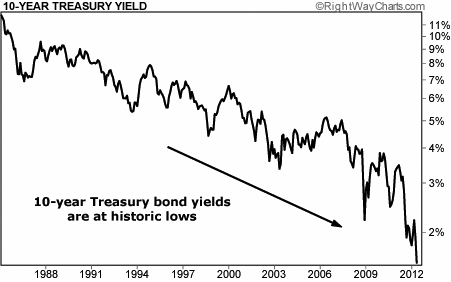Why interest rates matter to the stock market
Post on: 28 Май, 2015 No Comment

JohnNyaradi
John’s Latest Posts
The bond market is nervous over the Federal Reserve’s plans.
The recent wave of attention focused on the fate of the Federal Reserve’s quantitative easing program has attracted substantial concern regarding the health of the Treasury bond market — take a look at the iShares Trust Barclays 7-10 Year Treasury Bond Fund IEF, -0.15% Although there has been plenty of hand-wringing about the impact to stock prices if the Fed pulls away the punch bowl, we have been presented with a wide spectrum of opinions concerning the reaction of the bond market to any strategy change implemented by the Fed in its bond-buying program.
A spike in Treasury bond yields, as seen, for example, through the iShares Barclays 10-20 Year Treasury Bond Fund TLH, +0.00% — could cause mortgages to become more expensive and dampen the housing-market recovery. Higher rates could also stall the broader economy and make credit less available to businesses — especially small businesses.
Optimists emphasize that a healthy transition away from quantitative easing will reveal a healthy bond market, where interest rates rise modestly, allowing a natural balance to return to the bond market, where yields are based on investor demand, rather than the mandate of a central bank.
Although the recent yield increase to 2.16% caused a bit of panic among commentators, the Dow Jones Industrial Average managed to close out the month of May above 15,000. With the Consumer Price Index demonstrating an inflation rate of just over 1% per year, the risk of inflation does not appear to be a significant threat at this point. Even with the 10-year Treasury bond yield at 2.16%, there is plenty of room to move before the yield reaches a threatening level. Most experts put that level at a yield rate of 6%.
Meanwhile, others just don’t have that much confidence in the Fed.
An outspoken critic of the Federal Reserve, Ben Bernanke and the quantitative-easing programs has been Pimco’s managing director, Bill Gross. Gross has repeatedly pointed out that before QE began, stocks and bonds had a negative correlation: as stock prices would rise, bond prices would fall. In the age of quantitative easing, the opposite has become true. This has resulted in less savings because of lower interest rates, a push toward investing in stocks because that’s where the yield is, as well as the destruction of business models which were based on organic demand rather than Fed-manipulated demand.
Gross sees bubbles everywhere. The Fed-induced push toward stocks has created a stock-market bubble that could pop when the herd of investors is no longer corralled toward equities and Fed-created demand for bonds, which will likely evaporate when quantitative easing ends.
In between these two extremes are those who hope that the transition away from quantitative easing will be executed carefully enough to allow organic demand to return to the bond market, without causing what Warren Buffet calls an exodus from bonds.
A quick glance at the chart of the 10-year Treasury yield shows us a significant trend reversal beginning last August with a golden crossover of the 50-day moving average climbing above the 200-day moving average in early 2013. After putting in what appears to be an interim bottom in May, the yield on the 10-year appears to be climbing again in anticipation of a possible change to the interest-rate environment going forward.
This change in climate could be extremely significant for the U.S. stock market and overall economy as both have become highly complacent and dependent upon low interest rates.
Now, the true challenge for the Fed will be its exit strategy for its bond-buying program and whether or not it can be successful without roiling global financial markets. Is the Fed up to fulfilling this phase of its task? Time will tell. Wall Street Sector Selector remains in red flag status, expecting a high-risk environment ahead.














